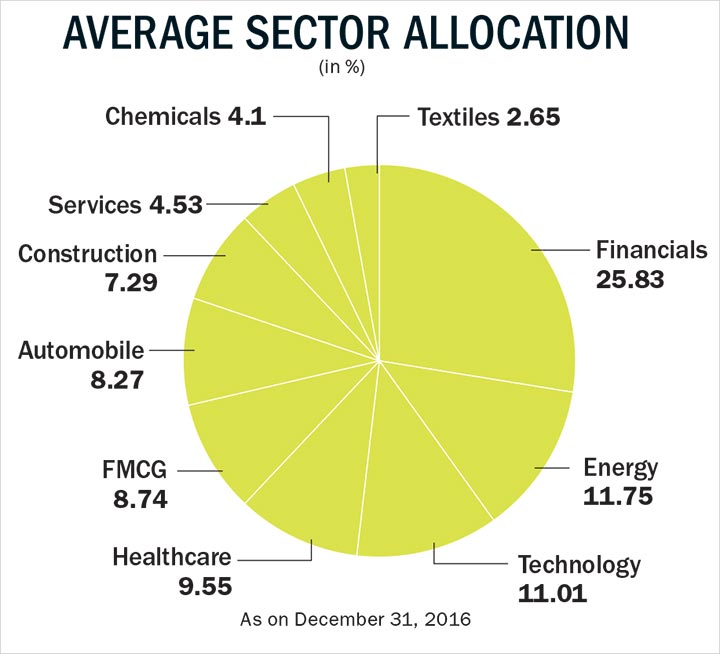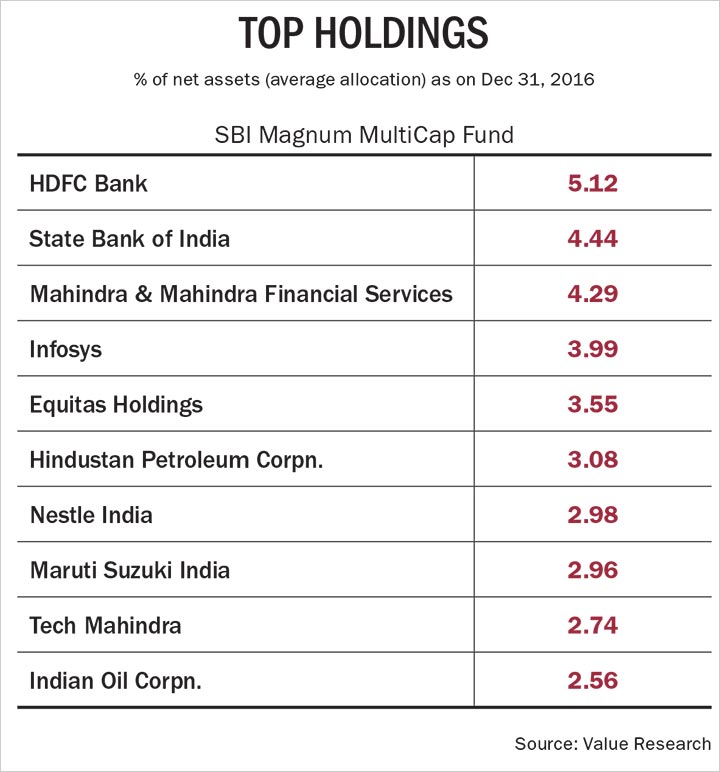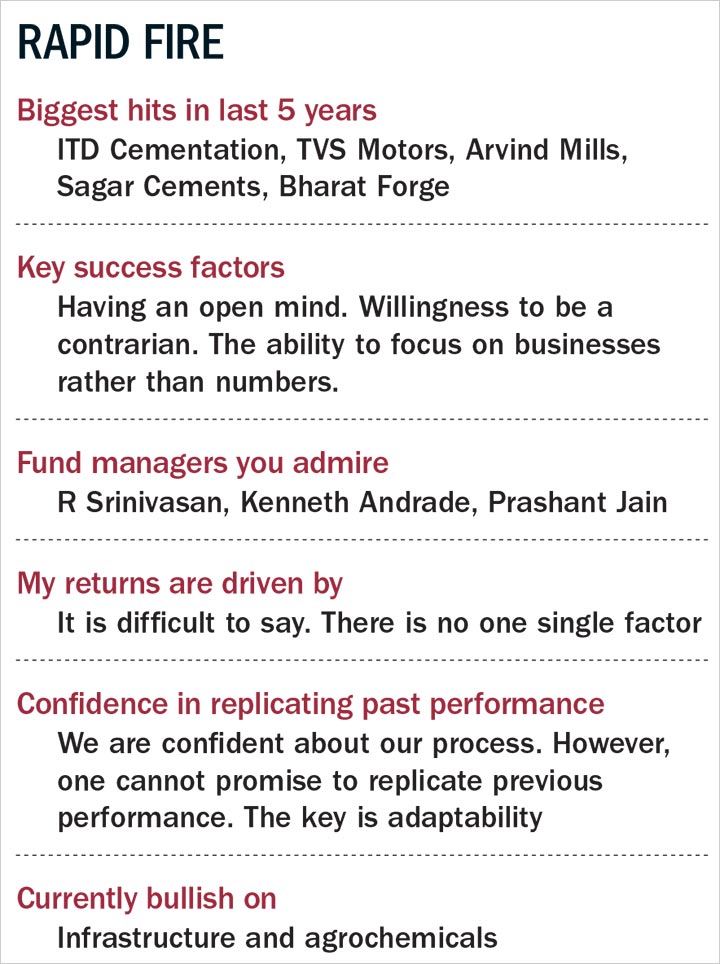Not many fund managers you meet use Sherlock Holmes as an analogy to explain their approach. However, Richard of AMC cites Arthur Conan Doyle’s creation and his detective work in the story, “The dog that didn’t bark” to make his point. He says that the job of a fund manager requires a similar deductive thought process to unearth the far-reaching impact of news flow or to cut through market noise or to identify a change in trend.
The nature of the thematic funds that D’Souza handles — SBI Magnum Comma Fund (Commodities), SBI PSU Fund and SBI Infrastructure Fund — is such that decibel levels are always high and many times confusing. However, D’Souza’s funds have done well over the past 3 years. The commodities fund has given a return of 25.15%; the infrastructure fund and PSU fund have posted a return of 25.49% and 19.59%, respectively. D’Souza’s funds are closely linked to the capex cycle and the investment climate is yet to recover from the sluggish patch it hit in the aftermath of the global financial crisis in 2008.
Growing up in a middle-class home in Dombivli, D’Souza says much of his learning has come from his habit of reading. He would borrow books from a friend and that helped him inculcate the habit. When he was in college, D’Souza’s reading led him to business magazines and that piqued his interest in equity research.
He started his journey in equity research on the sell-side with Vajani Securities in 1992. The research division there was headed by Lalji Lakhamshi Chheda who taught him the important lesson that the numbers are already in the price. Chheda instilled in D’Souza that the only way to make a good return is to figure out what could happen to the company.
Equity research was still at a very nascent stage in 1992. As D’Souza recalls, it was a bit like the Wild West. There was no SEBI and companies’ financials were not easily accessible. “We would go down to the STD booth to call up companies that were out of Mumbai — they wouldn’t publish their financials in papers — to get their half-yearly results. We manually built the database. At that point of time, companies didn’t report quarterly results,” he says.
While he learnt the importance of imagination at his first job, he learnt the importance of caution from Jayesh Parekh, MD of Sunidhi Consultancy which he joined in 1997. “Jayesh Parekh was such a cautious man that he would start reading an annual report from the last page. This is where all the provisions and the notes to accounts are mentioned. We learnt from observing him that everything should be taken with a pinch of salt. You start with the bad story first and then move onto other things,” says D’Souza.
His next stint with Rohit Kothari, the promoter of Four Dimensions, helped him to add another facet to his imagination. “He taught me to further expand my thinking and ask whether the company’s profit can equal its current market-cap, to understand the size of the opportunity,” he says. The investment would effectively be free for the investor if a company could generate earnings equal to its market cap.
D’Souza got his chance to manage money at ASK Investment Managers where he moved in 2008. “Here one had to construct a portfolio for clients. There was a certain rigour there. You had to prepare an investment thesis and present it to the entire team. I was handling a Rs.150 crore portfolio,” he says.
In 2010, D’Souza joined SBI AMC as a fund manager in the PMS division. However, after SBI AMC decided to shutter the PMS business in 2011, D’Souza was shifted to the AMC. He handled the Tax Advantage series and the Capital Protection funds. In 2014, there was a shuffling at SBI AMC and D’Souza got the thematic — commodities, PSU and infrastructure — funds that he manages at present.

When D’Souza started managing these funds in 2014, he had his work cut out. The underlying sectors were not doing well. Commodities were still in a free fall and nobody knew for sure when the prices would bottom out. Some excitement had built around infrastructure following Modi’s victory, but that excitement also started to fizzle out soon as not much was happening on the ground. Private capex was also muted.
The initial years, D’Souza says, were spent in trying to protect the NAVs from falling further. In the commodities fund, some of D’Souza’s initial bets were made in the agrochemical and the coffee space. CCL Products became part of the SBI Magnum Comma Fund’s portfolio in the month of September, 2014. The stock’s average price during the month was Rs.108. Data from Value Research shows that the fund had exited the stock in the month of March, 2016 when the average closing price was Rs.188.
D’Souza likes to invest in companies which are changing at the margin and suddenly showing higher growth than historical averages. He assesses if these companies can sustain the growth momentum for the next 3-4 years. He also likes to invest in companies that are under-owned or under-appreciated. Something similar was transpiring at CCL Products. The company was growing above its long-term average. For instance, in 2QFY15, CCL’s topline had grown 49% YoY, based on improved product mix and lower green coffee prices.
While the rest of the commodity names were struggling, CCL was setting up a plant at Dak Lak province in Vietnam which had good access to green coffee beans. The easy access to raw materials would help CCL save on logistics costs. The plant also had zero tax on profit for the first four years and duty benefits on exports. “The management was clearly focused on what they wanted to do. They wanted to focus on processing raw coffee and supply the processed coffee to other branded players. The company seemed to be moving in the right direction,” he says.
Sharda Cropchem was another bet that helped the fund recover some of its lost NAV. The company is engaged in distribution and marketing of a wide range of agrochemical formulations and generic active ingredients used in fungicides, herbicides and insecticides. D’Souza picked up a chunk of the shares during the IPO in September 2014. He bought 1.02 lakh shares of the company which accounted for 3.02% of the company’s equity. The bet paid off almost instantly. The stock ended with a 48% gain on the listing day itself. From the issue price of Rs.156, the stock now trades at Rs.457 and is still part of the Comma Fund.
D’Souza was again impressed with the management. “Mr. Bubna spoke about the business with clarity, there was no ambiguity. He had charted out his territory and was clear that he wanted to continue with an asset-light model. He knew the entry barriers for his business were registrations in Europe and Latam markets. He knew he would source from China and needed to maintain quality control. We liked what we saw and heard,” says D’Souza. He and his team also did some checks and found out that registrations were, indeed, a key entry barrier. “The business was not easy. It wasn’t that anybody could source from China and sell it to Europe,” he says.

Another stock that has worked well for SBI Magnum Comma Fund is Sagar Cements. The stock was already part of the fund’s portfolio before D’Souza took over. However, D’Souza almost doubled the investment. When D’Souza took over in August, 2014, the fund held a 2.8% stake and the stock was trading at Rs.344. Since then, the stock has gained 122% and SBI Comma Fund’s holding has increased to 5.21%. D’Souza also bought the stock for his infrastructure fund in April, 2015.
D’Souza’s thesis was that the market was getting bigger for cement companies in Andhra Pradesh. “Post the split in 2014, Andhra Pradesh wanted to build its capital city of Amaravati and Telangana wanted to focus on irrigation projects. We also liked that the promoters of Sagar Cements had a reputation for being technocrats. Everything worked out well and the investment has done well for the fund,” says D’Souza.
These investments helped the funds to further recover. In August, 2014, the Comma fund was still 16% below its level in beginning 2008, more or less in line with Nifty Commodities’ 18% correction during the same period. A year later after D’Souza’s arrival, Nifty Commodities index corrected another 20%, but the Comma Fund slipped just 6%.
Commodities have been going south since the 2008 financial crisis. In 2015, there was still not any firm sign of a turnaround. However, D’Souza sensed that a recovery was around the corner. “While sentiment remained negative, commodity prices were showing a spurt. I felt that commodity prices could start to mean revert from hereon. The prices had fallen below the cost of production and something had to give. I didn’t have any numbers to back this, but it seemed inevitable. So, I started buying metal stocks,” says D’Souza.
 This is the time, when the Comma Fund bought names like Hindalco and Nalco. The bets worked out well. The fund bought Hindalco in December 2015, when the average price of the stock was Rs.80. The stock is presently trading 127% higher. Nalco was included in the portfolio in November, 2015, when the stock’s average price was Rs.38. The stock now trades at Rs.68. The fund’s bet on OMCs post deregulation also helped it make good money. When the Comma Fund bought Indian Oil in August, 2015, the stock was trading at Rs.202. Today, it trades at Rs.384, which is a 90% gain. “The government has stuck to its intent on deregulating prices. We were worried that when prices start rising, the government may not act accordingly. But, they stuck to the course and that helped OMCs quite a bit and pushed them into another orbit in terms of earnings,” he says.
This is the time, when the Comma Fund bought names like Hindalco and Nalco. The bets worked out well. The fund bought Hindalco in December 2015, when the average price of the stock was Rs.80. The stock is presently trading 127% higher. Nalco was included in the portfolio in November, 2015, when the stock’s average price was Rs.38. The stock now trades at Rs.68. The fund’s bet on OMCs post deregulation also helped it make good money. When the Comma Fund bought Indian Oil in August, 2015, the stock was trading at Rs.202. Today, it trades at Rs.384, which is a 90% gain. “The government has stuck to its intent on deregulating prices. We were worried that when prices start rising, the government may not act accordingly. But, they stuck to the course and that helped OMCs quite a bit and pushed them into another orbit in terms of earnings,” he says.
The SBI Infrastructure Fund has also remained under dark clouds in the aftermath of the 2008 crisis. In August, 2014, when D’Souza took over, the Infrastructure Fund was trading 34% below what it was trading during the beginning of 2008. The Nifty Infrastructure Index had fallen 48% during the same period. A year after D’Souza took over; the Infrastructure Fund gained 9.6% even as the Nifty Infrastructure Index cracked another 9%. D’Souza says to protect returns of his funds; he started to identify companies that had strong technical expertise and would do well once there was a recovery.
The fund bought into stocks like ITD Cementation and Elgi Equipments. In September 2014, when ITD Cementation was included in the portfolio, the price of the stock stood at Rs.44. The stock currently trades at Rs.150. ITD Cementation was going through some bad times because of economic conditions and certain mistakes that were not of its own making. It had money due from the NHAI and its low-margin projects were also delayed because of land acquisition issues.
When D’Souza met the management, he realised that the company’s core competence couldn’t be easily replaced. ITD Cementation was likely to qualify for several orders that were coming up due to its past track-record of successfully executing large projects. The plans for Mumbai Metro’s next phase got announced in 2014 which would have an underground network and ITD Cementation had worked in the Delhi Metro project. The Mumbai trans-harbour link was announced and JNPT expansion plan was also in the pipeline. ITD Cementation was well-known for its expertise in maritime projects. “The company had a fair chance of getting these projects as only a few companies would qualify for handling such projects,” D’Souza recalls.
The call to invest in air-compressor manufacturer Elgi Equipments was also supported by a similar thesis. Elgi Equipments is the second largest compressor maker in India. They had ventured into the US and Europe market at that point of time. D’Souza was again impressed with the management’s focus and ability. A chance interaction with a major MNC competitor in the air-compressor business who spoke highly of Elgi also reinforced the latter’s strong competence.

He says that he looks for companies that are showing signs of revival or improvement in operating performance. For instance, if a company has been showing negative cash flows for the last few quarters and starts to show improvement in operating margin.
He says that when he took over the funds, the sectors were at their worst. He started identifying companies that were showing some improvement in operational performance. He again cites ITD Cementation as an example. The company was looking to lighten up the debt on its books and its order book was also improving.
D’Souza says a key learning is to have a stop-loss when investments see a sharp correction. For instance, the Tax Advantage Fund had exposure to Wockhardt and had more than doubled its investment during its 3-4 year holding period. When the FDA crisis hit the pharma major in 2013, the stock plunged and the fund lost most of its profit.
Another learning D’Souza says has been to follow-up harder on potential opportunities. He cites the example of Hatsun Agro, which is a big dairy player down South. He says when he and his team looked at the company, it looked interesting. However, they couldn’t get access to the management and left it at that. The stock doubled from the price it was trading at.
He says that investing in commodity stocks is a tricky job as the sector is not only affected by domestic developments, but global events as well. He adds that it is about sensing that the sectoral dynamics might be about to enter a tough phase. If huge capacities are coming on stream and the prices start to peak out, it could be an indication that it might be time to book profits.
As D’Souza continues with his journey, he says that spending time with his wife and enjoying get-together dinners with his large family is what gives him the space to unwind. A man of simple tastes, D’Souza says there is nothing like immersing oneself in a book with a hot cup of coffee.











